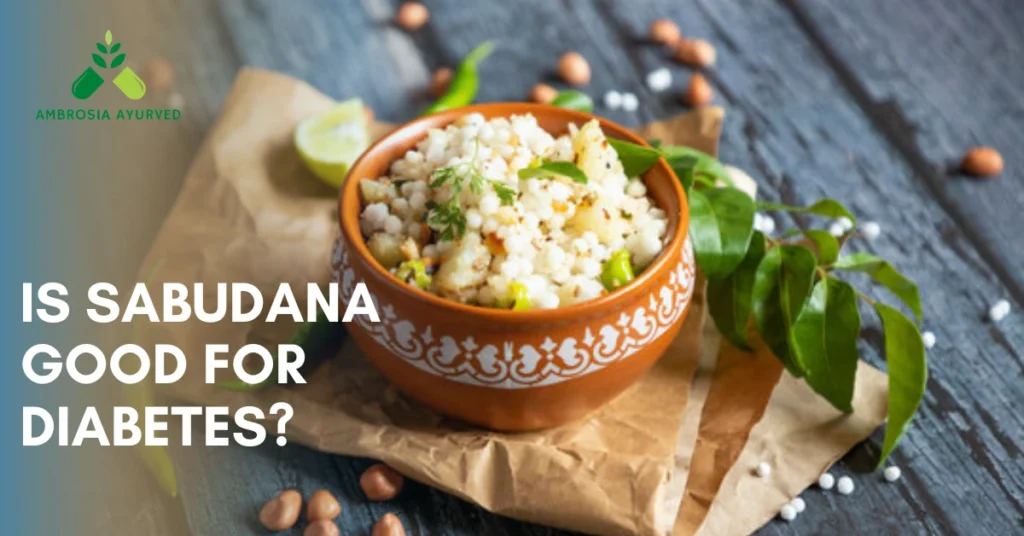Sabudana, commonly known as tapioca pearls, is a popular ingredient in Indian households, especially during fasting periods. Made from the starch extracted from the cassava root, it is high in carbohydrates and often used to prepare dishes like sabudana khichdi, vada, and kheer. Its chewy texture and quick energy release make it a go-to food during Navratri and other fasting days.
However, for people living with diabetes, every food choice counts, particularly when it comes to carbohydrate-rich foods. Since sabudana is mostly composed of starch, a natural question arises: Is sabudana good for diabetes?
Let’s take a closer, fact-based look at how sabudana affects blood sugar and whether it fits into a diabetic-friendly diet.
Nutritional Profile of Sabudana
Sabudana is primarily a source of carbohydrates, with very little protein, fiber, or fat. Here’s a breakdown of its approximate nutritional content per 100 grams of cooked sabudana:
- Calories: ~350 kcal
- Carbohydrates: 85–88 g
- Protein: 0.2–0.5 g
- Fat: 0.1 g
- Fiber: 0.9 g
- Sugar: 0–2 g (natural starch-based)
One of the most important factors to consider is its Glycemic Index (GI), which indicates how quickly a food raises blood sugar levels. Sabudana has a high GI, estimated at around 70 or above, making it a fast-digesting carbohydrate. This means it can cause a quick spike in blood glucose levels after consumption, a red flag for people managing diabetes.
Moreover, sabudana lacks significant micronutrients. It doesn’t offer much in terms of vitamins or minerals unless fortified or combined with other ingredients.
While it may be ideal for someone needing quick energy (e.g., during fasting or illness), its nutritional profile makes it a less suitable option for individuals with diabetes, especially when consumed in large or unbalanced portions.
Is Sabudana Good or Bad for Diabetes?
To put it simply, sabudana is not ideal for people with diabetes. The main reason lies in its high carbohydrate and starch content, which is quickly converted into glucose in the body. This rapid breakdown causes a sharp spike in blood sugar levels, something that diabetics must actively avoid.
Since sabudana is made almost entirely of simple carbs and contains little to no fiber, it gets digested very fast. Foods low in fiber do not slow down sugar absorption, making them risky for blood sugar control. Compared to complex carbohydrates like whole grains or legumes, sabudana provides energy quickly but without lasting satiety or nutritional value.
Additionally, sabudana lacks protein and healthy fats, which are essential for stabilizing blood glucose. When eaten alone or in large portions, it can lead to a quick sugar rush followed by a crash, both of which are harmful patterns for someone managing Type 1 or Type 2 diabetes.
That said, sabudana isn’t inherently “bad” — it’s just not a wise choice for regular or unmonitored consumption by diabetics. People who are insulin-resistant or on diabetes medication should be particularly careful, as it can interfere with blood sugar stability.
Sabudana is best categorized as a high-risk food for diabetes, especially when compared to lower-GI, fiber-rich alternatives.
When Can Diabetics Eat Sabudana?
While sabudana isn’t recommended for daily diabetic diets, it can be consumed occasionally, but with strict control.
Here are some safe use cases:
- ✅ Small Portions Only: Stick to ½ cup cooked sabudana at most.
- ✅ Always Pair with Protein/Fiber: Combine with peanuts, curd, or vegetables to reduce blood sugar spikes.
- ✅ Fasting Days (if advised): If sabudana is a tradition during fasts, take it once a day and monitor sugar levels.
- ✅ Check Your Sugar Response: Everyone reacts differently — use a glucometer to see how your body handles it.
- ✅ Doctor’s Guidance: Always better to get personalized advice if you’re on medication or insulin.
In short, sabudana is not “forbidden”, but it needs portion control, proper food pairing, and medical advice. Regular or large servings are not safe for diabetics.

Alternatives to Sabudana for Diabetics
If you enjoy sabudana but need to manage your blood sugar, here are some healthier alternatives. These options have a lower glycemic index, more fiber, and better nutritional value for people with diabetes:
1️⃣ Quinoa
- High in protein and fiber
- Slower impact on blood sugar
- Works well in khichdi-style recipes
2️⃣ Brown Rice
- Complex carbs that digest slowly
- Better than white rice or sabudana for blood sugar control
- Great for light pulao or rice bowls
3️⃣ Millets (like bajra, ragi, jowar)
- Naturally diabetes-friendly grains
- Rich in fiber and essential nutrients
- Suitable for porridge, upma, or rotis
4️⃣ Oats
- Excellent source of soluble fiber
- Helps regulate blood sugar levels
- Can be used in both sweet (sugar-free) and savory dishes
Tip: For best results, always pair these with a source of protein (like curd, paneer, or lentils) and vegetables to create a balanced meal.
Final Words
Sabudana may be light and easy to digest, but for people with diabetes, it’s not the best choice. It’s high carbohydrate and glycemic load can lead to quick blood sugar spikes, especially when eaten in large amounts or without balance.
That said, occasional consumption in small portions — with proper pairing and under medical guidance — may be manageable for some individuals. But as a regular part of a diabetic diet, sabudana is better replaced with healthier, slower-digesting alternatives like quinoa, oats, or millets.
Always remember: with diabetes, what you eat matters just as much as how much and how often you eat it.




